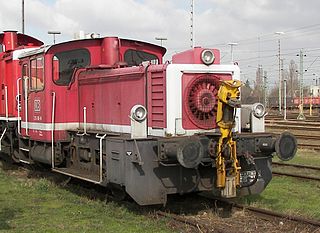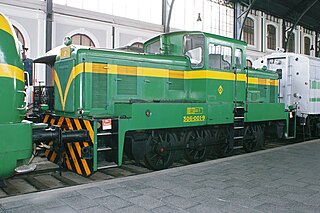| Córas Iompair Éireann E class (later 421 class) | |||||||||||||||||||||||
|---|---|---|---|---|---|---|---|---|---|---|---|---|---|---|---|---|---|---|---|---|---|---|---|
 E421 and E432 in 2008 | |||||||||||||||||||||||
| |||||||||||||||||||||||
| |||||||||||||||||||||||
| |||||||||||||||||||||||
| |||||||||||||||||||||||
The Córas Iompair Éireann 421 Class was a railway locomotive, built by the CIÉ at Inchicore Works between 1962–1963 and designed for branch line traffic use and shunting.
| Córas Iompair Éireann E class (later 421 class) | |||||||||||||||||||||||
|---|---|---|---|---|---|---|---|---|---|---|---|---|---|---|---|---|---|---|---|---|---|---|---|
 E421 and E432 in 2008 | |||||||||||||||||||||||
| |||||||||||||||||||||||
| |||||||||||||||||||||||
| |||||||||||||||||||||||
| |||||||||||||||||||||||
The Córas Iompair Éireann 421 Class was a railway locomotive, built by the CIÉ at Inchicore Works between 1962–1963 and designed for branch line traffic use and shunting.
The 421 Class was a larger development of the earlier 401 Class, and were fitted with a Maybach MD220 engine of 420 horsepower (310 kW) with diesel hydraulic transmission via a Mekydro KL64U transmission. Unlike the earlier E401 class, these locomotives were fitted for multiple operation. They were of C wheel arrangement.

The first of the class made its debut in early October 1962 on pilot duties in the Dublin area and although they had a design maximum speed of 100 km/h (62 mph), experience (notably the derailment of a trial train hauled by E421) showed that they did not ride well when travelling at speeds over 40 km/h (25 mph) and so henceforth were limited to that speed and used simply for shunting duties instead. They were numbered E421–E434, and were withdrawn from service between 1979 and 1983.
Three of these locomotives have been preserved, as follows:
The E421 was available as a resin model from "Q Kits", [2] but this company is no longer trading as the owner has retired.
Although prototype diesel locomotives ran in Britain before World War II, the railways of both the Republic and Northern Ireland changed over much more rapidly from steam to diesel traction than those in Britain, due to the island's limited coal reserves and an ageing steam locomotive fleet.
The Córas Iompair Éireann 301 Class locomotives were the first diesel locomotives used on the CIÉ network, this class of 5 being built between 1947 and 1948 by the company for shunting use, particularly in the railway yards on Dublin's North Wall. They were a six coupled locomotive, fitted with a Mirrlees TLDT6 engine of 487 horsepower (363 kW) with diesel-electric transmission via two Brush traction motors. Unusually, they lacked train vacuum brakes, although air brakes were provided for the locomotive itself.
The Córas Iompair Éireann 401 Class locomotives were built in 1957–1958 and designed for use on branch line traffic and shunting. They were fitted with a Maybach MD220 engine of 420 hp (310 kW), with diesel hydraulic transmission via a Mekydro KL64 transmission, and were of C wheel arrangement.
The Córas Iompair Éireann 601 Class locomotives were built in 1956-1957, by Motorenfabrik Deutz at Cologne, Germany. They were 3 small shunting locomotives of B wheel arrangement and were fitted with a Deutz V8 F8L 614 engine of 130 hp, with Voith hydraulic transmission and chain final drive. They weighed only 18 tons and had a maximum speed of 32 kilometres per hour (20 mph). These locomotives were never fitted with train brakes, so had limited usefulness compared to their successors, the G611 class. The G601 locomotives were withdrawn from service between 1965 and 1972.

The Córas Iompair Éireann 611 class locomotives were delivered from the manufacturers, Motorenfabrik Deutz at Cologne, Germany between December 1961 and February 1962, entering revenue earning service in the following August after receiving the new tan / black paint job at Inchicore.
The CIE 501 Class locomotives were built in 1955 by Walker Brothers of Wigan for use on the narrow gauge lines on the West Clare section of the CIÉ. They were small diesel mechanical locomotives, with a 0-4-0+0-4-0 wheel arrangement. Controlled from a central cab, the locomotives had two Gardner engines of 224 hp (167 kW), one under each end casing, driving through a fluid coupling and Wilson gear box the inner axle of the opposite bogie, through a spiral-bevel-reverse and reduction gear box. Unusually the locomotives were driven from a seat mounted sideways to the direction of travel giving a clear field of vision both ways by a mere turn of the head.

The Córas Iompair Éireann 113 class locomotives were the first mainline diesel locomotives used in Ireland, being built in January 1950 and October 1951 by CIÉ at their Inchicore Works. They were fitted with Sulzer 6LDA28 engines of 915 hp (682 kW), with four Metropolitan-Vickers MV157 traction motors. They were of Bo-Bo wheel arrangement, weighed 80 tonnes and had a maximum speed of 90 km/h (56 mph). They were initially numbered 1100–1101 in the steam locomotive number series, but were subsequently renumbered B113–B114 in 1957.

The Córas Iompair Éireann 101 Class locomotives, numbered B101-B112, were built in 1956 by the Birmingham Railway Carriage and Wagon Company. They were fitted with Sulzer 6LDA28 engines of 960 hp (720 kW), with four Metropolitan-Vickers MV137 traction motors. They were of A1A-A1A wheel arrangement, weighed 75 tonnes and had a maximum speed of 120 km/h (75 mph).

The Córas Iompair Éireann 201 Class was a class of 34 diesel electric locomotives manufactured by Metropolitan-Vickers at their Dukinfield Works in Manchester. They were a smaller, lighter and less powerful version of the 001 Class and were originally intended for branch line passenger and freight duties. They were introduced in 1956 and, although their duties changed over the years, were in regular service on the Irish railway network until the mid-1980s. Six were sold to Northern Ireland Railways (NIR) in 1986.

The Córas Iompair Éireann 121 Class was a railway locomotive which was manufactured by General Motors Electro-Motive Division. These locomotives were in regular service on the Irish railway network until 2002, with the last two remaining in service until early 2008.

The CIE 141 Class locomotives were built in 1962 by General Motors Electro Motive Division (EMD) in the United States. Numbered B141 to B177, they were an updated version of the 121 Class locomotives, mechanically very similar but with cabs at each end.

The British Rail Class 42 Warship diesel-hydraulic locomotives were introduced in 1958. It was apparent at that time that the largest centre of expertise on diesel-hydraulic locomotives was in West Germany. The Western Region of British Railways negotiated a licence with German manufacturers to scale down the German Federal Railway's "V200" design to suit the smaller loading gauge of the British network, and to allow British manufacturers to construct the new locomotives. The resultant design bears a close resemblance, both cosmetically and in the engineering employed, to the original V200 design. Warship locomotives were divided into two batches: those built at BR's Swindon works were numbered in the series D800-D832 and D866-D870, had a maximum tractive effort of 52,400 pounds-force (233,000 N) and eventually became British Rail Class 42. 33 others, D833–D865, were constructed by the North British Locomotive Company and became British Rail Class 43. They were allocated to Bristol Bath Road, Plymouth Laira, Newton Abbot and Old Oak Common.

The Railway Preservation Society of Ireland (RPSI) is a railway preservation group founded in 1964 and operating throughout Ireland. Mainline steam train railtours are operated from Dublin, while short train rides are operated up and down the platform at Whitehead, County Antrim, and as of 2023, the group sometimes operates mainline trains in Northern Ireland using hired-in NIR diesel trains from Belfast. The RPSI has bases in Dublin and Whitehead, with the latter having a museum. The society owns heritage wagons, carriages, steam engines, diesel locomotives and metal-bodied carriages suitable for mainline use.

The DB railways Köf III class are light two axle shunting locomotives of Deutsche Bahn AG.

The W class are a diesel-hydraulic shunting locomotive ordered and operated by the Victorian Railways of Australia.

The NZR DSA class locomotive was a type of 0-6-0DM diesel-mechanical locomotives built by three different manufacturers: W. G. Bagnall, Hunslet, Mitsubishi Heavy Industries, and Vulcan Foundry for the Drewry Car Co. They were built between 1953 and 1967.

The Yorkshire Engine Company Taurus and Indus locomotives were two very similar lines of 0-8-0, diesel-hydraulic locomotives that weighed 58 tons and had a maximum speed of 36 mph (58 km/h). The two Rolls-Royce C8SFL diesel engines gave a total of 600 hp (450 kW). The transmission of the Taurus locomotives worked on a similar principle to that of the Fell diesel tested during the early 1950s. In this case, at low speeds only one engine was used, the second being engaged between 3.5 mph and 15 mph to enable haulage of 300 - 500 ton loads at speeds of up to 36 mph. The maximum speed with one engine was 12 mph (19 km/h) while the minimum speed with both engines was 3.5 mph (5.6 km/h). Both engines drove to a common torque converter and used a common throttle control with a separate lever being provided to engage the second engine as the need arose.
The GS&WR 400 class or CIE class B2/B2a were a class of ten 4-6-0 steam locomotives built for the Great Southern & Western Railway (GS&WR) between 1916 and 1923 for express passenger duties on the Dublin to Cork main line. They proved initially unreliable but rebuilds from four to two cylinders between 1927 and 1937 for the seven survivors produced locomotives yielding satisfactory performance with the last two being withdrawn in 1961.

Inchicore railway works, also known locally as 'Inchicore' or 'The Works', was founded by the Great Southern and Western Railway in 1846 and emerged to become the major engineering centre for railways in Ireland. Located c. 3 km west of Dublin city centre, the works cover an area of approximately 73 acres (300,000 m2).
The class WDS-3 was a diesel-hydraulic locomotive used by Indian Railways for shunting and doing departmental works. The model name stands for broad gauge (W), diesel (D), shunting (S) 3rd generation (3). The WDS-3 is used mostly in the Northern Railway Zone (NR). All these locomotives were withdrawn and scrapped by the late 1990s.